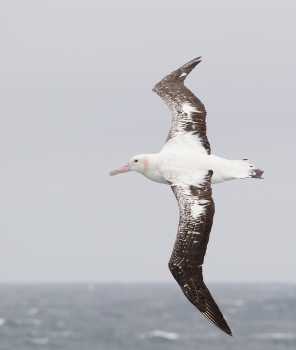Philip Richardson and colleagues have published open access in the journal Movement Ecology on modelling at-sea flight of globally Vulnerable Wandering Albatrosses Diomedea exulans using GPS tracking data and concurrent information on wind speed.
The paper’s abstract follows:
“Background
Albatrosses and other large seabirds use dynamic soaring to gain sufficient energy from the wind to travel large distances rapidly and with little apparent effort. The recent development of miniature bird-borne tracking devices now makes it possible to explore the physical and biological implications of this means of locomotion in detail. Here we use GPS tracking and concurrent reanalyzed wind speed data to model the flight performance of wandering albatrosses Diomedea exulans soaring over the Southern Ocean. We investigate the extent to which flight speed and performance of albatrosses is facilitated or constrained by wind conditions encountered during foraging trips.
Results
We derived simple equations to model observed albatross ground speed as a function of wind speed and relative wind direction. Ground speeds of the tracked birds in the along-wind direction varied primarily by wind-induced leeway, which averaged 0.51 (± 0.02) times the wind speed at a reference height of 5 m. By subtracting leeway velocity from ground velocity, we were able to estimate airspeed (the magnitude of the bird’s velocity through the air). As wind speeds increased from 3 to 18 m/s, the airspeed of wandering albatrosses flying in an across-wind direction increased by 0.42 (± 0.04) times the wind speed (i.e. ~ 6 m/s). At low wind speeds, tracked birds increased their airspeed in upwind flight relative to that in downwind flight. At higher wind speeds they apparently limited their airspeeds to a maximum of around 20 m/s, probably to keep the forces on their wings in dynamic soaring well within tolerable limits. Upwind airspeeds were nearly constant and downwind leeway increased with wind speed. Birds therefore achieved their fastest upwind ground speeds (~ 9 m/s) at low wind speeds (~ 3 m/s).
Conclusions
This study provides insights into which flight strategies are optimal for dynamic soaring. Our results are consistent with the prediction that the optimal range speed of albatrosses is higher in headwind than tailwind flight but only in wind speeds of up to ~ 7 m/s. Our models predict that wandering albatrosses have oval-shaped airspeed polars, with the fastest airspeeds ~ 20 m/s centered in the across-wind direction. This suggests that in upwind flight in high winds, albatrosses can increase their ground speed by tacking like sailboats.”

Wandering Albatross at sea, photograph by John Chardine
With thanks to Richard Philips.
Reference:
Richardson, P.L., Wakefield, E.D. & Phillips, R.A. 2018. Flight speed and performance of the Wandering Albatross with respect to wind. Movement Ecology doi.org/10.1186/s40462-018-0121-9.
John Cooper, ACAP Information Officer, 09 March 2018

 English
English  Français
Français  Español
Español